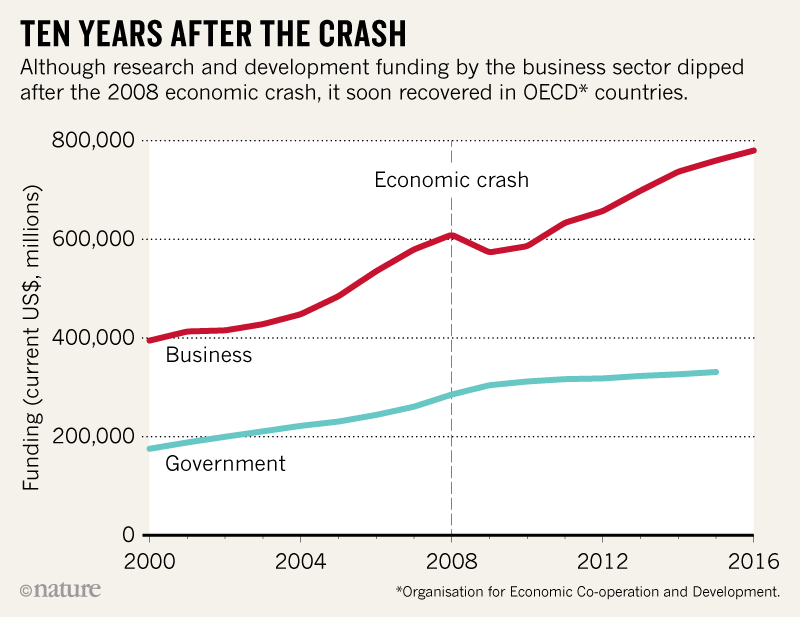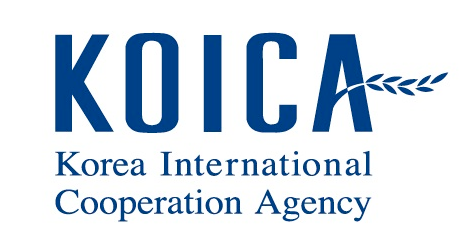
The world's economy came crashing down a decade ago.Credit: Andrew Winning/Reuters
Ten years ago this week, the world’s economy came crashing down — a crisis encapsulated by the demise of the US investment bank Lehman Brothers, which filed for the largest bankruptcy in history on 15 September 2008. What followed is a familiar tale: a tightening of purse strings the world over, in governments, businesses and households, and broad uncertainty over how long the recession would persist.
A decade on, Nature looks at how funding for research — which relies on both government and private investment — has fared around the world, and where it stands today.
The big picture
Data from the Organisation for Economic Co-operation and Development (OECD) show there has been a steady growth overall in research and development (R&D) funding since the initial aftermath of the crash.
Among the organization’s 36 countries — which include the United States, Japan and many European nations — R&D funding from businesses dipped briefly, but then recovered and has climbed since.
Government funding generally rose in the two years after the crisis, possibly reflecting attempts to stimulate their economies (see ‘Ten years after the crash’).
Disparities exist between countries, however. Some are still reeling from the economic crash, and even those that have recovered are experiencing shifts in how research is funded.

Source: OECD
Europe
The various directions R&D funding has taken in Europe underscore the economic disparities between countries.
In nations such as Germany, Denmark and the United Kingdom, which have strong economies and innovation sectors, R&D funding levels remained robust in both the public and private sectors. Germany, for example, has increased its public funding by 46% since 2008, from US$23 billion to $34 billion in 2016.
In central and eastern European countries, such as the Czech Republic, Hungary and Poland, both business and government R&D funding has generally climbed steadily after the crash.
Much of this stability, however, was thanks to the European Union’s structural funds, which are routinely given to member nations to help mitigate regional disparities in wealth across Europe. Those funds dramatically compensated for the negative effects of the crash, a 2017 study found1.
But in southern European countries hit hardest by the recession, such as Greece and Spain, R&D funding from the government plummeted and has not fully recovered. Spain’s public funding dropped by 25% between 2009 and 2016, from $9.6 billion to $7.1 billion. As a result, many southern European countries have become dependent on EU structural funds.
Consequently, the gap between countries’ levels of investment in science is growing, says Teemu Makkonen, an economist at the University of Eastern Finland in Joensuu. “If you have fewer funds to play around with, then you have to make cuts.”
United States
Much like the overall trend for OECD countries, business expenditures on R&D in the United States initially nose-dived by roughly 10%, from $259 billion in 2008 to $233 billion in 2010, as measured in current US dollars.
Government spending, by contrast, received a boost of 8%, from $124 billion in 2008 to $134 billion in 2010. That shift occurred largely because of the American Recovery and Reinvestment Act, the US government’s legislative attempt to jumpstart the economy by investing in innovation.
After 2010, business expenditures began to climb and have continued to rise. In 2016, the latest year for which data are available, business expenditure reached $319 billion.
Government funding, however, flatlined after the crash, and has declined as a percentage of gross domestic product, from 0.88% in 2009 to 0.62% in 2015.
Scientists are now required to demonstrate the broader impacts, especially economic benefits, of their research when applying for government funding, says Julia Lane, an economist at New York University. Universities have taken it upon themselves to demonstrate those links, says Lane. “And they’ve been very effective at going on the Hill and going to their state legislatures to make their case.”
But other funding sources have also emerged. “The philanthropic foundations have really stepped up to the plate,” says Lane. Organizations such as the Alfred P. Sloan Foundation and Foundation, and the Bill and Melinda Gates Foundation have contributed millions of dollars to the sciences over the past few years.
East Asia
Except for Japan’s business sector, which saw an 11% drop between 2008 and 2009 from $116 billion to $103 billion before recovering, OECD countries in East Asia have maintained growth in research funding from both government and businesses.
But while the overall amount of funding has grown yearly — the rate of growth has slowed down in some places.
In South Korea, one of the world’s top investors in research, public R&D funding increased by 11% between 2008 and 2009, but only by a 1% from 2017 to 2018. That change has left young researchers struggling to compete with more-experienced researchers for limited funds, says So Young Kim, a political scientist at the KAIST Graduate School of Science and Technology Policy in Daejeon, South Korea.
The country also has a growing gap between government and business R&D funding. Business investment rose from being $20 billion higher than public R&D investment in 2009 to being $42 billion higher in 2016.
“Right now, R&D is mostly given to the areas that will bring up the most tangible results,” Kim says — something that will offer a return of investment. “But scientists these days are calling for support that is given just to science done for curiosity.”
Next ten years
No one knows for sure what the future holds for research funding.
Makkonen says that if the EU wants to foster cohesion and equality across the continent, then countries still suffering from the economic crisis need more funding to get them started.
For the United States, Lane says, the level of government funding is dependent on whether there’s a change in the presidential administration. The current administration has “been doing their best to kill science,” she says.
And in South Korea, Kim says, public perception of science has changed tremendously since the crisis, largely because of environmentally destructive projects put in motion under the previous government. That perception change probably contributed to the slowed increases in government research spending.
“Now, the public is becoming increasingly critical of what scientists are doing,” she says. “Who’s going to raise the voice that we need more funding for science? It’s not only going to be scientists who could succeed in reversing the trend. There must be public support for the scientific community. But that’s now very questionable.”
doi: 10.1038/d41586-018-06634-4
References
1.Izsak, K. & Radošević, S. Sci. Public Policy 44, 274–283 (2017).








